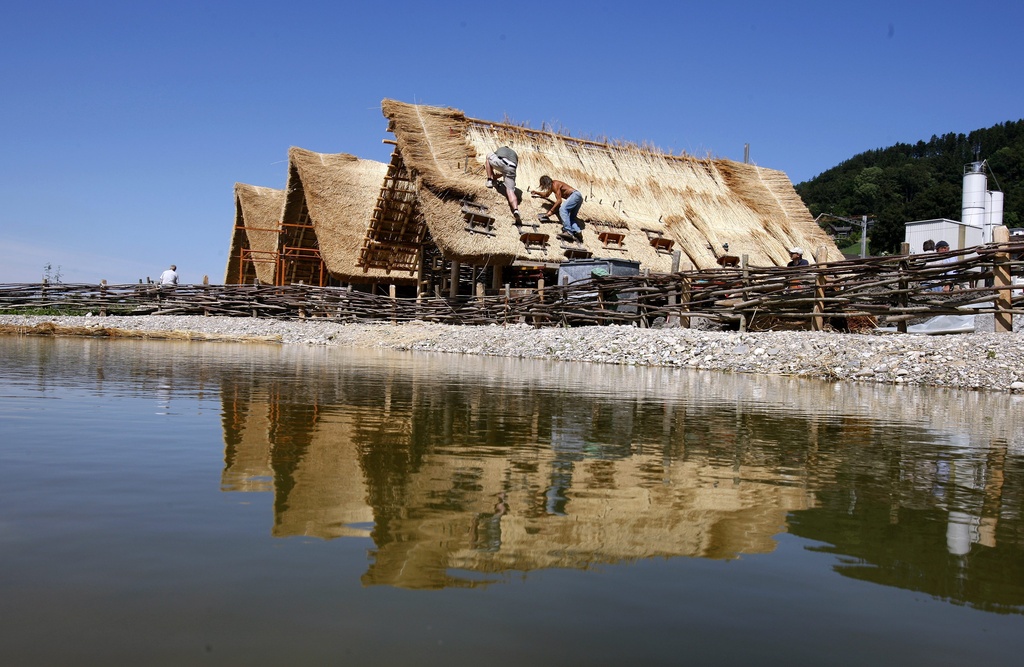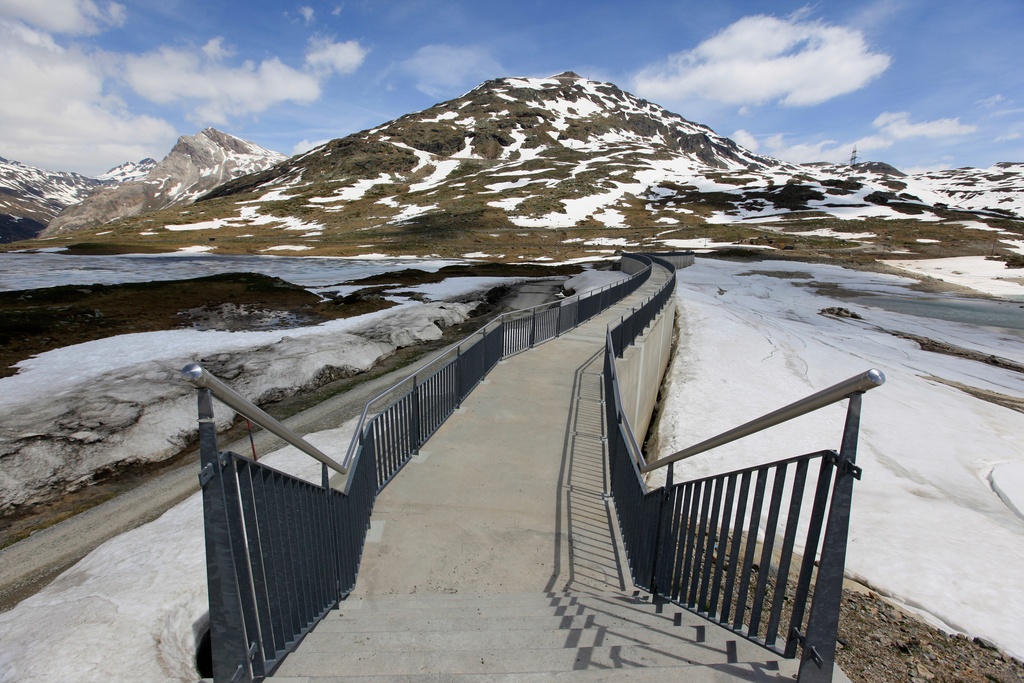Lake dwellings reveal hidden past

The prehistoric lake dwellings of the alpine region, including Switzerland, provide a unique glimpse of life in the earliest agricultural settlements from 5,000 to 500 BC.
Stretching across six European countries, they were added to the Unesco World Heritage List in June 2011. There are 111 sites in all, with 56 of them in Switzerland.
The dwellings in France, Switzerland, Germany, Austria, Italy and Slovenia, lie deep in lakes or buried in sand on lake shores. Yet for Unesco, they qualify as part of the cultural heritage of humanity: the pile-dwelling sites (as they are called) constitute some of the most important archaeological evidence of the ascent of man between the Neolithic and Bronze Ages.
The water and the sand of the lakes have created exceptional conditions in which this immense record of prehistory has been preserved.
The organic material used by our distant ancestors – wood, leather, bone, cloth and even left-over food – is preserved much better than anywhere else in this aquatic environment, protected as it is from exposure to air, inclement weather and the forces of human destructiveness.
First discovered a century and a half ago, the pile-dwelling sites of the alpine region have provided specialists with a unique opportunity to reconstruct what life was like in early societies of farmers and herdsmen during the millennia before Christ. These sites point to the missing link in the chain between the hunter-gatherers of pre-history and the first European civilisations.
Skilful peoples
The first traces of an ancient lake-dwellers’ village were found in Lake Zurich in 1854, a year in which the waters of the lake dropped to an exceptionally low level. Excavations revealed hundreds of wooden piles, driven into the earth, along with all sorts of unusual objects, extremely well preserved.
The discovery received attention all over Europe. In the decades that followed, remains of similar settlements were found on the shores of lakes in other European countries, notably in the alpine region.
Prior to the discovery, archaeological investigation of pre-history had found evidence of human mortality more than anything else – tombs, weapons and military strongholds – and so the lake-dweller villages provided the first testimony to the everyday life of European peoples between 5,000 and 500 BC.
In the earliest times, communities were generally small, made up of fewer than 50 people, divided up into five or ten households. Later, during the Bronze Age, villages might number up to 50 households comprising several hundred people.
The inhabitants lived by agriculture – almost exclusively cereals – and raising cattle, sheep and pigs, but also by hunting and fishing, and gathering herbs and fruits in the surrounding woodlands.
Utensils of wood and stone, shoes and clothing made of treated bark, pottery, jewellery, wheels, dug-out canoes and the first products of metalwork bear witness to the skills of the lake-dwellers.
They document the technological, economic and social development of an era which still remains shrouded in mystery. Even today we know hardly anything of the culture, customs and language of these far-off ancestors.
National myth
The rediscovery of the first traces of pile-dwellings in Switzerland gave rise to a picturesque image of people living on the waters of lakes in houses built on wooden platforms supported by piles and linked to one another by footbridges. Exhibitions, paintings, calendars, school books and novels fed the myth of the lake-dwellers for decades afterward.
The lakeshore settlements, found in different regions of Switzerland, also fed the idea that the various Swiss cultures shared a common origin, thus helping to bolster a sense of national identity in the country which had only acquired a centralised government in 1848. It was not by accident that the Swiss government chose a painting of a lake village to represent Switzerland at the Paris World Exhibition of 1867.
As time went on, however, archaeological research showed that lakeshore villages were built throughout the alpine region thousands of years ago and that they were inhabited by some 30 different peoples. The houses were not in fact built on platforms out on the water.
“In those days the lakes were smaller: the villages were built on dry land or in marshy areas. The piles really served to protect the inhabitants from flooding, since the water level varied much more than it does today,” Christian Harb, head of the heritage project on pile-dwellings, told swissinfo.ch.
International character
The pile dwellings nevertheless have remained in the national consciousness.
Speaking at the official ceremony to inscribe the sites onto the World Heritage list in September 2011, Interior Minister Didier Burkhalter, who himself grew up on the banks of Lake Neuchâtel, described how he used to go out on his grandfather’s fishing boat and had to be careful not to damage the nets on the submerged poles. The lake dwellings were an integral part of his childhood.
Recent research has, however, uncovered that pile dwellers were much more international than thought, with many ties between the various populations.
“There was a lot of mobility, a kind of free movement well before our time,” Burkhalter said.
Transnational cooperation was also a feature of the project to make the sites a World Heritage Site. It was promoted and led by Switzerland, but had the support of the five other countries.
Harb said that this was a factor in the project’s success as Unesco seeks to encourage cultural cooperation between member countries.
“In addition, there are very few prehistoric sites on the world list so far, and that, unlike other projects, the pile-dwellings have no potential for tourism – since they are all under water,” he added.
The authors of the proposal hope, however, that their success will serve as a renewed stimulus for archaeological research and make the museums and exhibition sites which feature the lake villages known to a wider public.
Last but not least, they hope it will result in preservation initiatives – the lake waters have kept their precious secrets well, but will not do so for ever.
The 111 sites in the Alpine region were added to the Unesco World Heritage list in June 2011. The pile dwellings were all built from around 5000 to 500 B.C. on the edges of lakes, rivers or wetlands.
There are sites in Switzerland (56), France (11), Italy (19), Germany (18), Austria (5) and Slovenia (2).
The Swiss Federal Culture Office and the Swiss Coordination Group Unesco Palafittes coordinated the candidacy for the Unesco World Heritage list.
An international coordination group looks after the management of the Unesco sites. Protection of the sites is carried out in accordance with countries’ different systems. Collaboration is aimed at promoting conservation of the sites, scientific exchange and to inform the public.
Some sites can be visited as they have been reconstructed. In Switzerland this includes at Latenium, the archaeological museum in Neuchâtel, at Gletterens in canton Fribourg and at Wauwil in canton Lucerne.
There is also a Palafittes Guide application for iPhone and Android offering information – also in English – on the sites and museums.
The Unesco committee has rejected for the second time in June 2011 a proposal to include Le Corbusier’s architectural works on the list.
The proposal was submitted by France, together with Switzerland, Germany, Belgium, Argentina and Japan. Three of the 19 sites selected were in Switzerland.
The rejection followed a recommendation against adding the works by the International Council on Monuments and Sites.
The building techniques were an issue and the 19 sites chosen did not adequately reflect Le Corbusier’s work, the Federal Culture Office said.
Born in 1887 in La Chaux-de-Fonds in Switzerland, Le Corbusier is regarded as one of the most innovative architects of the past century. His works are still an object of study and a source of inspiration for contemporary architecture.
(Translated from Italian by Terence McNamee)

In compliance with the JTI standards
More: SWI swissinfo.ch certified by the Journalism Trust Initiative














You can find an overview of ongoing debates with our journalists here . Please join us!
If you want to start a conversation about a topic raised in this article or want to report factual errors, email us at english@swissinfo.ch.